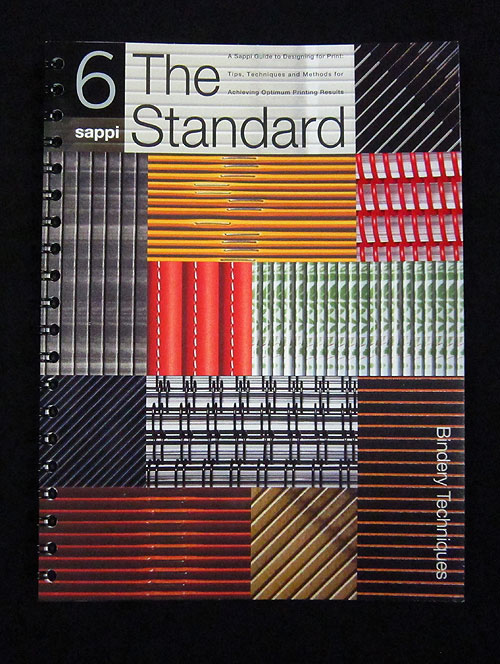

Sappi, Boston, Massachussetts, released its newest book in The Standard series, The Standard 6, which focuses on binding techniques and showcases bindery from its early beginnings to present day.
The Standard series began publication in 2005 with Volume 1 on Pre-Press techniques. Volume 2 featured color management and calibration; Volume 3 illustrated varnishes and coatings; Volume 4 highlighted Scoring and Folding; and Volume 5 dealt with Special Effects.
Patti Groh, Sappi North America’s director of marketing and communications, is the driving force behind the creative guide. “As we looked at the body of work from one to five, we felt that binding was a necessary subject matter to tie the series together,” said Groh. “This is the end of the first volume of The Standard. That’s why we ended up choosing binding.”
Starting on this project, she didn’t see how Sappi could produce a book that could match the visual impact of The Standard 5, yet a stellar book was produced that shows binding techniques in a unique and reader-friendly format.
Design and techniques
 The Standard 6 has five sections: the history of binding, binding as design, binding techniques, a guide to binding materials and a glossary.Groh hired Kit Hinrichs, owner of Studio Hinrichs in San Francisco, to do the entire series of The Standard books. Hinrichs draws upon his rich background and depth of knowledge about printing and finishing for each of the books. However, this project was unique because a bindery museum is located across the street from his office. Hinrichs spent a lot of time on historical research, which then was used in creating a graphic novel within The Standard 6 to illustrate the origins of binding.
The Standard 6 has five sections: the history of binding, binding as design, binding techniques, a guide to binding materials and a glossary.Groh hired Kit Hinrichs, owner of Studio Hinrichs in San Francisco, to do the entire series of The Standard books. Hinrichs draws upon his rich background and depth of knowledge about printing and finishing for each of the books. However, this project was unique because a bindery museum is located across the street from his office. Hinrichs spent a lot of time on historical research, which then was used in creating a graphic novel within The Standard 6 to illustrate the origins of binding.
Going into the project, there were no predetermined techniques that Sappi planned to highlight in the book. To determine what techniques to feature, Groh involved the printer early on in the process. Sappi hired Classic Color out of Chicago, working specifically with Jeff Hernandez, who has a strong grasp on new binding techniques. Delphine Hirasuna wrote the text for The Standard 1-6; and Groh, Hernandez and Hinrichs worked with a consultant to fully flesh out the history of binding.
The Standard 6 has five sections: the history of binding, binding as design, binding techniques, a guide to binding materials and a glossary. Sappi also offers the binding materials guide as a separate piece.
“It’s amazing as a resource,” said Groh. “I love the techniques, embossing and how it feels. All the little details make it feel lifelike.”
Hinrichs said the entire The Standard series is an important resource for the industry. “Sappi is the only paper company that is doing educational work for the design and business community. They’ve done it for dozens of years. They are really there to help educate this next generation of designers,” he said.
The Standard 6 has many unique features, such as QR Codes that take readers to videos demonstrating techniques like perfect binding. The book doesn’t simply write about the 22 featured binding techniques – it also offers readers tactile binding samples.
Production

The Standard 6 went through multiple passes on the printing press to create a unique look, utilizing a combination of UV inks and specialty coatings from Toyo. The cover had 15 registered press units and two registered coating passes.
There were several production challenges throughout the piece. The illustrations in The Standard 6 used a lot of black ink, and working a project through finishing and bindery operations on all black can be difficult. Sappi overcame challenges to avoid fingerprints by coating the inks with a matte strike through varnish, which kept the fingerprinting to a minimum. The book then went through a white cotton glove assembly process while collating and before it went through the final binding.

Binding the book also posed a challenge, according to Hinrichs. “How do you have books within books and different kinds of binding within each book?” Stitched, sewn, folded and drilled binding samples are located throughout, and all the pieces had to fit together into one completed project. There were a total of four bindings in the book, including saddlestitching, side sewing and perfect binding. Then all pages and sections were gathered, round hole punched, collated and assembled with a reverse gate cover with a 3/8-inch double wire-o binding lap.
A Komori LS 40-inch 8-color fully inter-decked UV press was used with a custom coating tower. A Stahl folder performed the folding, and a Bobst 106 was used for the embossing and channel scoring. A JBI BB400 in-line automatic wire-o binding machine completed the project.
Print community response
Sappi’s official launch of The Standard 6 was on October 6, 2015, at the American Bookbinders Museum in San Francisco, California. Groh said the book has received an amazing response. “The people who have seen it were in love with the book and stood in line for quite a bit of time to have Kit sign it,” Groh said. “People have learned so much from reading it.”
In the finished product, Sappi produced an elegant tool that will encourage the creative community to view binding as a design element.

